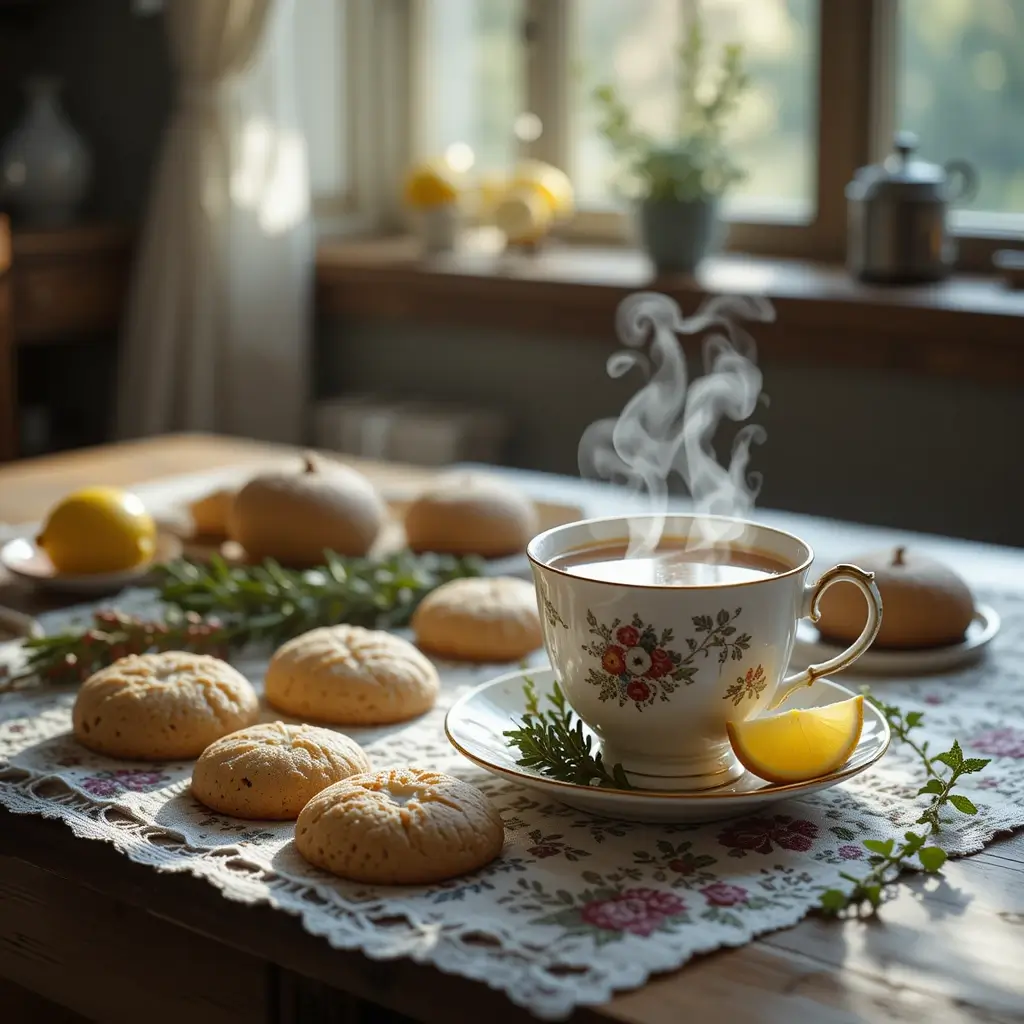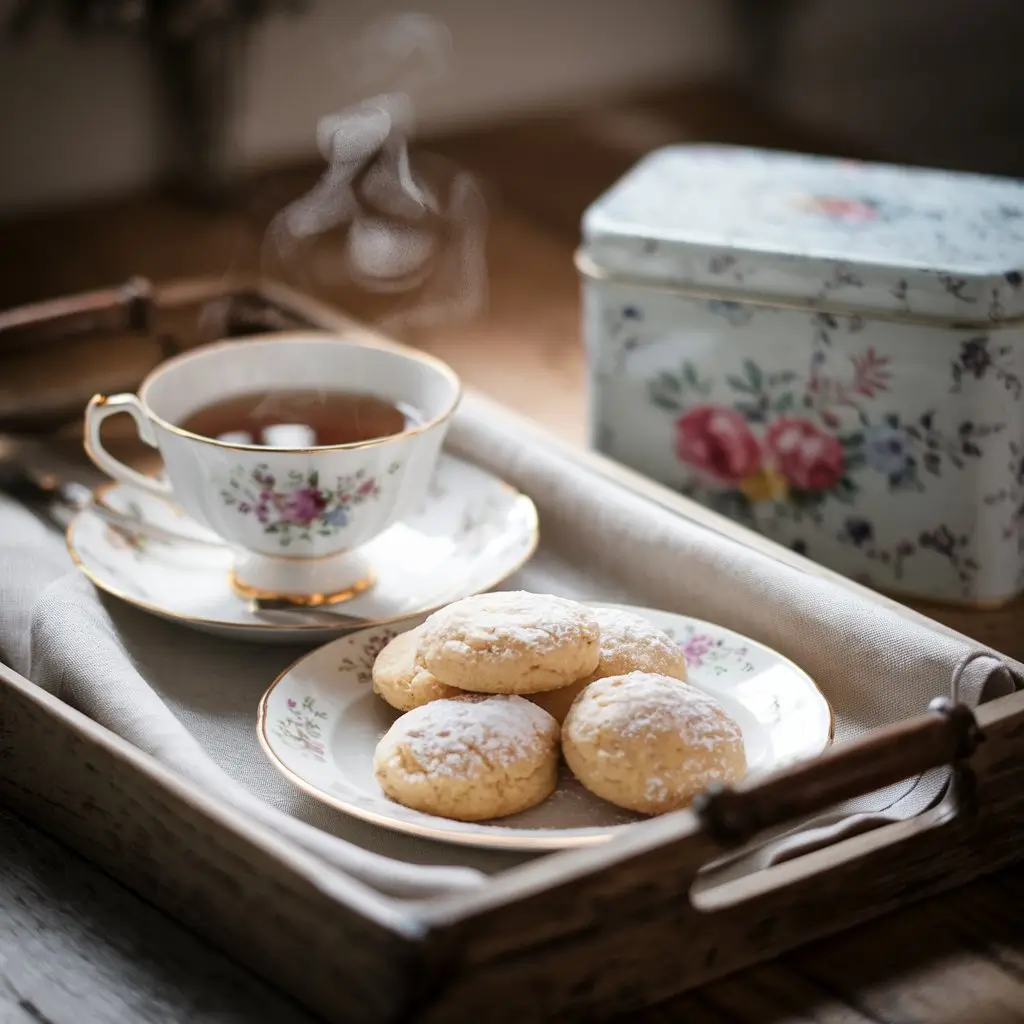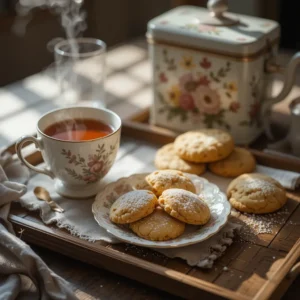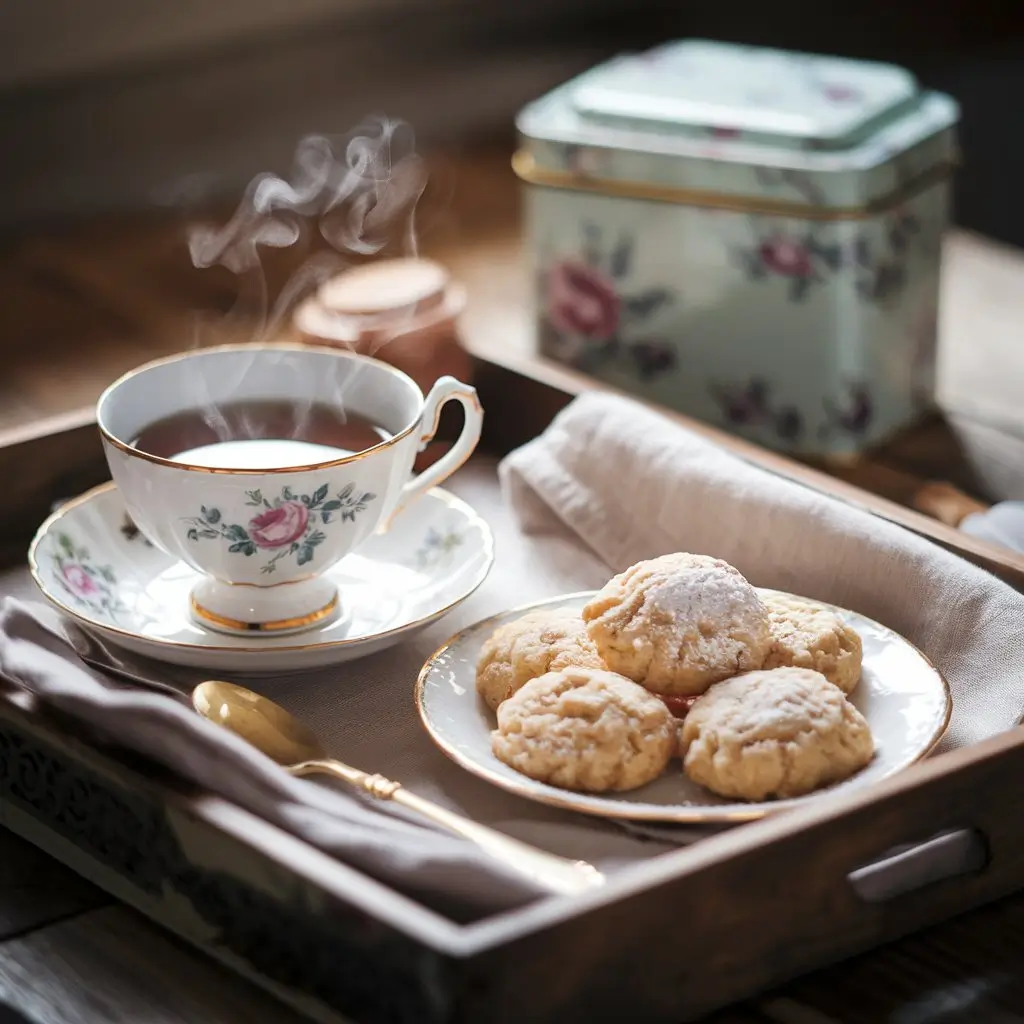Breakfast, often hailed as the most important meal of the day, deserves a delightful twist now and then. The time has come for tea enthusiasts along with those who seek distinct morning treats to start loving Earl Grey cookies. Traditionally, cookies aren’t associated with the breakfast table; however, this recipe breaks that mold most deliciously.
To begin with, Earl Grey brings a burst of citrusy, floral elegance that sets it apart from other black teas. When infused into a buttery cookie dough, it transforms the humble cookie into something both comforting and refined. In fact, it’s this very combination of sophistication and simplicity that makes these cookies ideal for an early-morning pick-me-up.
Moreover, they pair beautifully with your favorite warm beverage—whether it’s a hot cup of tea, a rich espresso, or a creamy chai latte. As a result, these cookies don’t just satisfy a sweet tooth; they elevate your breakfast experience altogether.
So, if you’re looking for a new addition to your breakfast menu that’s flavorful, elegant, and undeniably crave-worthy, these Earl Grey cookies are sure to impress. Let’s dive into this one-of-a-kind recipe that’s winning hearts (and mornings) across the globe.
Earl Grey Cookies
At first glance, Earl Grey cookies might seem like a curious twist on a classic. However, once you’ve tasted them, you’ll understand why they’re quickly becoming a favorite among global food lovers. Essentially, these cookies combine the soft, buttery texture of traditional shortbread or sugar cookies with the delicate, citrusy essence of Earl Grey tea. As a result, you get a cookie that’s fragrant, flavorful, and far more sophisticated than your average breakfast bite.
In particular, the magic lies in the use of ground tea leaves. Rather than infusing liquid tea, this recipe incorporates the actual leaves—finely ground—to ensure a more concentrated and evenly distributed flavor. Additionally, the slight bitterness of the black tea balances beautifully with the sweetness of the cookie dough, offering a taste experience that’s both rich and refreshing.
Consequently, Earl Grey cookies are not only delicious but also highly versatile. Whether you enjoy them with your morning coffee, as a mid-day snack, or paired with a warm cup of tea during a cozy evening, they always manage to feel appropriate—yet indulgent. So, it’s no surprise that this unique recipe has earned its place on many breakfast tables around the world.
Why Earl Grey is a Breakfast Game-Changer
To truly appreciate the brilliance of this cookie, we must first understand what makes Earl Grey tea so special. Black tea receives its distinctive floral and zesty aroma from bergamot infusion, which transforms the tea from ordinary into extraordinary. Thanks to this distinctive note, Earl Grey stands out in both flavor and fragrance—making it an ideal component for creative culinary applications.
Furthermore, its natural caffeine content provides a gentle energy boost, which is perfect for mornings when you need a little motivation. Unlike a strong cup of espresso that can feel overpowering, Earl Grey offers a smooth, subtle wake-up call. Therefore, it brings a sense of calm alertness, making it a more balanced choice for many.
On top of that, its flavor profile pairs harmoniously with ingredients often found in breakfast dishes—like honey, lemon, vanilla, and cream. As a result, when used in cookies, muffins, or even oatmeal, it enhances the overall experience without overwhelming your palate.
In short, Earl Grey isn’t just a drink—it’s a culinary inspiration. Whether you’re using it to flavor your baked goods or sipping it alongside your breakfast, it adds an unmistakable elegance that turns even a simple morning into a gourmet affair.

Who Will Love These Cookies? (Hint: Everyone)
Without a doubt, Earl Grey cookies are made for anyone who appreciates the finer things in life—especially when they come in cookie form. First and foremost, tea enthusiasts will be thrilled by the aromatic depth that only Earl Grey can provide. In addition, foodies who constantly seek new and unique breakfast ideas will find these cookies to be an exciting departure from the ordinary.
Surprisingly, even those who typically shy away from tea might find themselves enchanted by the way the bergamot blends subtly into the buttery dough. Moreover, the recipe is approachable enough for novice bakers, yet refined enough to impress the most seasoned home chef. As a bonus, kids love the gentle sweetness, and adults appreciate the sophisticated flavor—making these cookies a crowd-pleaser across all age groups.
So, whether you’re baking for your family, hosting a brunch, or preparing a thoughtful edible gift, these cookies are bound to charm every bite.
What You Need to Make Earl Grey Cookies
Before you begin, make sure you’ve gathered all your ingredients. Having everything ready will help the process flow smoothly and make baking a breeze. The good news? The list is short, simple, and filled with pantry staples—plus a touch of culinary flair.
| Ingredient | Amount |
|---|---|
| Unsalted butter (softened) | 1 cup (2 sticks) |
| Powdered sugar | ½ cup |
| All-purpose flour | 2 cups |
| Ground Earl Grey tea | 2 tablespoons (about 3 tea bags) |
| Vanilla extract | 1 teaspoon |
| Fine sea salt | ¼ teaspoon |
Optionally, you can add lemon zest for brightness or a sprinkle of turbinado sugar for a delightful crunch on top.
Additionally, you’ll want to have a few essential tools on hand: mixing bowls, a hand or stand mixer, a silicone spatula, parchment paper, and a baking sheet. By preparing these in advance, you’ll avoid interruptions and enjoy a more relaxed baking experience.
How to Properly Infuse Tea in Baking
Now that your ingredients are ready, let’s talk about the most crucial step—infusing the Earl Grey tea. Rather than steeping the tea in water, which can dilute the flavor, we’re going to incorporate the tea leaves directly into the dough. This way, the full intensity of the tea’s citrus and floral notes shines through in every bite.
To start, use loose leaf Earl Grey or cut open high-quality tea bags. Then, grind the tea into a fine powder using a spice grinder or mortar and pestle. This step is essential because large tea leaf pieces can feel gritty and uneven in baked goods. A fine texture, on the other hand, blends seamlessly into the dough.
Alternatively, if you want to amplify the flavor even more, you can steep the tea in melted butter before chilling it and creaming it into the sugar. Although this adds an extra step, the result is a rich, infused base that carries the bergamot essence even further.
In conclusion, properly preparing your tea is what elevates these cookies from good to unforgettable. So, take your time here—it’s worth it.

Step-by-Step Earl Grey Cookies Recipe
Now that you’re prepped and ready, it’s time to bring this recipe to life. These instructions are carefully designed to ensure your cookies come out perfectly every time. So, grab your apron and let’s get baking!
1: Cream the Butter and Sugar
To begin with, place the room-temperature butter and powdered sugar in a large mixing bowl. Using a stand mixer or handheld beater, cream the mixture on medium speed for about 2–3 minutes, or until it becomes pale, light, and fluffy. This step is essential for incorporating air and achieving that soft, tender texture.
2: Add Vanilla and Earl Grey Tea
Next, add in the vanilla extract and the finely ground Earl Grey tea. At this point, your kitchen should already begin to smell like a cozy tea house. Mix until the tea is evenly distributed throughout the butter mixture.
3: Combine Dry Ingredients
In a separate bowl, whisk together the flour and salt. Then, gradually add the dry mixture to the butter-tea blend. Mix slowly until a soft dough forms. Be careful not to overwork the dough, as this can make the cookies tough instead of melt-in-your-mouth soft.
4: Chill the Dough
Once your dough is ready, shape it into a log and wrap it tightly in plastic wrap. Chill in the refrigerator for at least 30–45 minutes. Why? Because chilled dough not only makes slicing easier but also prevents the cookies from spreading too much during baking.
5: Slice and Bake
Chill the mixture first and then preheat the oven to 350°F (175°C) while you cover your baking sheet with parchment paper. Slice the dough into ¼-inch rounds and place them evenly spaced on the tray. Bake for 10–12 minutes or until the edges are lightly golden.
6: Cool and Serve
Finally, transfer your cookies to a wire rack and let them cool completely. Meanwhile, brew yourself a fresh cup of Earl Grey—you’ve earned it. Once cooled, enjoy them plain, dusted with powdered sugar, or dipped in white chocolate for an extra indulgent twist.
How to Maximize the Earl Grey Flavor
As you may have noticed, the flavor of these cookies hinges on how well you handle the tea. Thankfully, there are several ways to ensure that the bold, citrusy notes of Earl Grey truly stand out.
One effective technique is to grind the tea leaves extra fine. This ensures they blend seamlessly into the dough and release their essential oils during baking. Additionally, consider using a double-infusion method: steep the tea leaves in melted butter for 10–15 minutes, then strain and cool the butter before using it in the dough. Although this requires a bit more effort, the flavor payoff is absolutely worth it.
Furthermore, don’t shy away from flavor-enhancing companions. A touch of lemon zest, for instance, brightens the citrus notes, while a splash of vanilla complements the floral tones. In short, every small adjustment has the potential to create a more dynamic flavor profile.
To sum up, the secret to bold, fragrant cookies lies in preparation. So, take your time during the infusion steps—you’ll be rewarded with cookies that taste as elegant as they smell.
Why Room Temperature Butter is Non-Negotiable
Believe it or not, the temperature of your butter can make or break your baking experience. That’s because, at room temperature, butter blends more easily with sugar, creating the air pockets necessary for a light and tender crumb.
If you use cold butter, it won’t incorporate smoothly, leading to a dense, uneven dough. On the other hand, overly melted butter will result in cookies that spread too much and lose their shape. Therefore, achieving that soft, spreadable consistency—cool to the touch but not hard—is absolutely essential.
To clarify, you’ll know your butter is ready when you can press a finger into it and leave a slight dent without it collapsing. If you forgot to leave it out, don’t panic! Cut it into small cubes and let it sit for 15 minutes, or warm it gently in the microwave at 20% power for short intervals.
In conclusion, when it comes to baking perfect Earl Grey cookies, starting with properly softened butter ensures a smoother process and far tastier results. So, don’t skip this step—it’s more important than you might think.

Tips for That Perfect Earl Grey Cookie
When it comes to baking, even the smallest details can make a world of difference. To ensure your Earl Grey cookies come out perfectly every time, keep the following expert tips in mind. These little adjustments can elevate your baking from good to extraordinary.
First and foremost, always measure your ingredients accurately. While it may seem obvious, using too much flour or not enough butter can drastically affect texture. For best results, use a digital kitchen scale to keep everything precise.
Next, consider chilling your dough longer than the minimum suggested time. Although 30 minutes works, letting the dough rest for a few hours—or even overnight—deepens the flavors and improves texture. As a result, your cookies will hold their shape better and taste even more divine.
Additionally, make sure you’re using freshly ground Earl Grey tea. Pre-ground or older leaves may lack the punchy bergamot notes that make these cookies shine. Besides that, using high-quality tea leaves (loose-leaf if possible) will enhance both aroma and flavor.
Another useful trick is to rotate your baking tray halfway through the baking time. Ovens often have hot spots, and this simple step ensures even browning.
Lastly, let your cookies cool completely before storing. Placing them in an airtight container while still warm can lead to sogginess. Instead, allow them to crisp up on a wire rack, ensuring that satisfying bite every time.
In essence, small steps—like chilling, rotating trays, or weighing ingredients—can make a big difference. So, treat this recipe with care, and it will reward you with exceptional results.
Flavor Variations of Earl Grey Cookies
While the classic version is already a delight, sometimes it’s fun to play around and get a little creative in the kitchen. Fortunately, Earl Grey cookies are wonderfully versatile, allowing for countless flavor combinations and fun twists.
To begin with, consider adding lemon zest to your dough. Not only does this complement the citrus notes in Earl Grey, but it also adds a burst of brightness that makes each bite more refreshing. Alternatively, try orange zest for a more mellow, rounded citrus flavor.
If you’re a fan of floral notes, incorporate a hint of dried lavender. Start with just ¼ teaspoon—this powerful ingredient goes a long way. Combined with the bergamot, it creates an elegant, almost perfume-like profile that’s ideal for afternoon tea or bridal showers.
For those who crave richness, dip the cooled cookies in melted dark or white chocolate. Let the chocolate set before serving. As a result, you get an irresistible blend of bitter, sweet, and citrus.
Prefer a nutty dimension? Finely chopped pistachios or almonds can be folded into the dough or sprinkled on top just before baking. Not only do they add texture, but their earthy flavor balances the floral tones beautifully.
Furthermore, for a festive variation, add a pinch of ground cardamom or cinnamon. These warm spices pair surprisingly well with Earl Grey, especially during cooler months.
Lastly, if you’re feeling adventurous, use Earl Grey-infused sugar in place of plain sugar. Simply store sugar with a few Earl Grey tea bags in an airtight jar for a few days—voilà, you’ve got fragrant sugar ready to use.
In conclusion, Earl Grey cookies serve as the perfect canvas for creativity. So, don’t be afraid to experiment—you might just discover your new favorite version.
Substitution Ideas for Allergies & Preferences
Thankfully, even if you have dietary restrictions or specific ingredient preferences, you can still enjoy the delicious charm of Earl Grey cookies. With just a few smart substitutions, this recipe becomes incredibly inclusive without compromising on taste or texture.
To start, if you’re avoiding dairy, replace the butter with a high-quality plant-based alternative. For example, vegan butters made from coconut oil or avocado oil offer similar richness and structure. Be sure, however, to choose unsalted versions to maintain the balance of flavor.
In case you’re sensitive to gluten, swap the all-purpose flour for a gluten-free 1:1 baking blend. These are widely available and usually contain xanthan gum or similar binders to mimic the elasticity of wheat. Additionally, adding a tablespoon of cornstarch helps keep the texture tender and crumbly.
Prefer natural sweeteners? Instead of powdered sugar, you can use coconut sugar or maple sugar. Bear in mind, these will change the flavor slightly, giving the cookies a warmer, more caramel-like tone. Nevertheless, the unique pairing with Earl Grey still works beautifully.
Moreover, if you’re out of vanilla extract or want a different twist, try almond extract or rose water—but use sparingly, as these flavors are potent. By doing so, you can personalize your batch while keeping the core identity of the recipe intact.
Ultimately, baking should be joyful and adaptable. So, whether you’re cooking for someone with food allergies or just trying something new, these substitutions allow you to tailor the recipe to your needs—without sacrificing that signature Earl Grey elegance.

What to Serve With Earl Grey Cookies
Once your cookies are perfectly baked and cooled, the next exciting step is deciding how to enjoy them. Whether you’re hosting brunch, sipping solo, or planning a picnic, these pairing ideas take your experience to the next level.
Naturally, the first and most harmonious choice is a cup of hot Earl Grey tea. The shared bergamot notes create a delicious echo of flavor that enhances every bite. However, you don’t have to stop there.
For a creamy contrast, serve the cookies alongside a latte, cappuccino, or chai. The warmth and spice from these drinks create a beautiful balance with the cookie’s citrusy profile. If you prefer something colder, an iced matcha latte or cold brew works wonderfully, especially in warmer months.
Furthermore, these cookies pair delightfully with fresh fruit. Try strawberries, raspberries, or sliced peaches on the side for a refreshing pop of color and tartness. Better yet, serve them with a yogurt parfait for a breakfast that feels indulgent yet balanced.
For a heartier spread, include Earl Grey cookies in a breakfast grazing board. Add items like scones, mini muffins, granola bars, cheese, and dried fruit. In doing so, you create a dynamic presentation that’s perfect for sharing.
Lastly, if you’re in a dessert mood, sandwich a scoop of vanilla or honey-lavender ice cream between two cookies. Not only is it decadent, but it’s also a fun and unexpected treat for guests.
In short, Earl Grey cookies are incredibly versatile. So, no matter how you choose to enjoy them, there’s always a delicious companion that brings out their best qualities.
A Brief History of Earl Grey and Its Culinary Journey
Before we dive deeper into the cookie itself, it’s worth exploring the fascinating origins of Earl Grey tea—the ingredient that lends this recipe its name and unmistakable flavor. After all, understanding its history adds a layer of appreciation to every fragrant bite.
To begin with, Earl Grey tea is named after Charles Grey, the 2nd Earl Grey, who served as Prime Minister of the United Kingdom from 1830 to 1834. According to legend, he received a gift of tea flavored with bergamot oil as a diplomatic gesture either from a Chinese envoy or as thanks from a man whose son had been saved from drowning by one of Grey’s men. Regardless of the version, what’s clear is that the tea’s unique flavor quickly became a household favorite in British society.
Over time, Earl Grey gained global recognition. Thanks to its distinctive blend of robust black tea and aromatic bergamot citrus, it became more than just a breakfast staple—it became a cultural icon. Soon after, its uses expanded beyond teacups. Cooks, bakers, and mixologists began incorporating the tea into a wide variety of recipes, from cakes and scones to ice creams and even cocktails.
Interestingly, the integration of Earl Grey into cookies is a relatively modern development. As baking trends evolved, especially with the rise of artisanal and small-batch bakeries, creative chefs began experimenting with infusing tea into pastries. Not long after, the Earl Grey cookie was born—delicately balancing buttery sweetness with a floral, citrusy kick.
Today, these cookies are celebrated not only in tea rooms across England but also in cozy cafés from Tokyo to Toronto. Moreover, the global embrace of tea culture has made them especially popular among food bloggers, brunch lovers, and home bakers seeking something just a little different.
More Breakfast Recipes to Try
If you love Earl Grey Cookies, you’ll want to try more Breakfast recipes that are just as easy and delicious! Here are a few must-try options:
- Honeybun Cake Recipe
- Pumpkin Chocolate Chip Cookies
- Balkan Breakfast Recipe
- Brownies Recipe
- Pumpkin Muffin Recipe
FAQs
Yes, just ensure it’s finely ground for a smooth texture.
Yes, but very mild. One or two won’t spike your energy.
Absolutely! It brings a lighter, grassier taste.
Powdered sugar gives a melt-in-the-mouth texture.
Chill the dough and use parchment paper.
Of course! Just mix in two batches for best consistency.

The Magic of Earl Grey Cookies for Breakfast
Equipment
- Mixing Bowls
- Hand or stand mixer
- Measuring cups & spoons
- Silicone spatula
- Baking sheet
- Parchment Paper
- Plastic wrap
- Wire cooling rack
- Spice grinder or mortar & pestle
Ingredients
- 1 cup Unsalted butter
- ½ cup Powdered sugar
- 2 cups All-purpose flour
- 2 tbsp Ground Earl Grey tea
- 1 tsp Vanilla extract
- ¼ tsp Fine sea salt
- ½ tsp (Optional) Lemon zest
Instructions
- Cream butter and sugar until fluffy (2–3 minutes).
- Add vanilla & ground, Earl Grey, mixing until blended.
- Whisk flour and salt separately, then combine with the wet mixture to form a dough.
- Chill dough (30–45 minutes) wrapped in plastic.
- Slice chilled dough into ¼-inch rounds and place on a lined baking sheet.
- The baking time should be at 350°F (175°C) for 10–12 minutes until the edges turn light brown.
- The finished dish needs to cool down on a wire rack both for serving and preserving.

I like ur sweet breakfast chef 😋